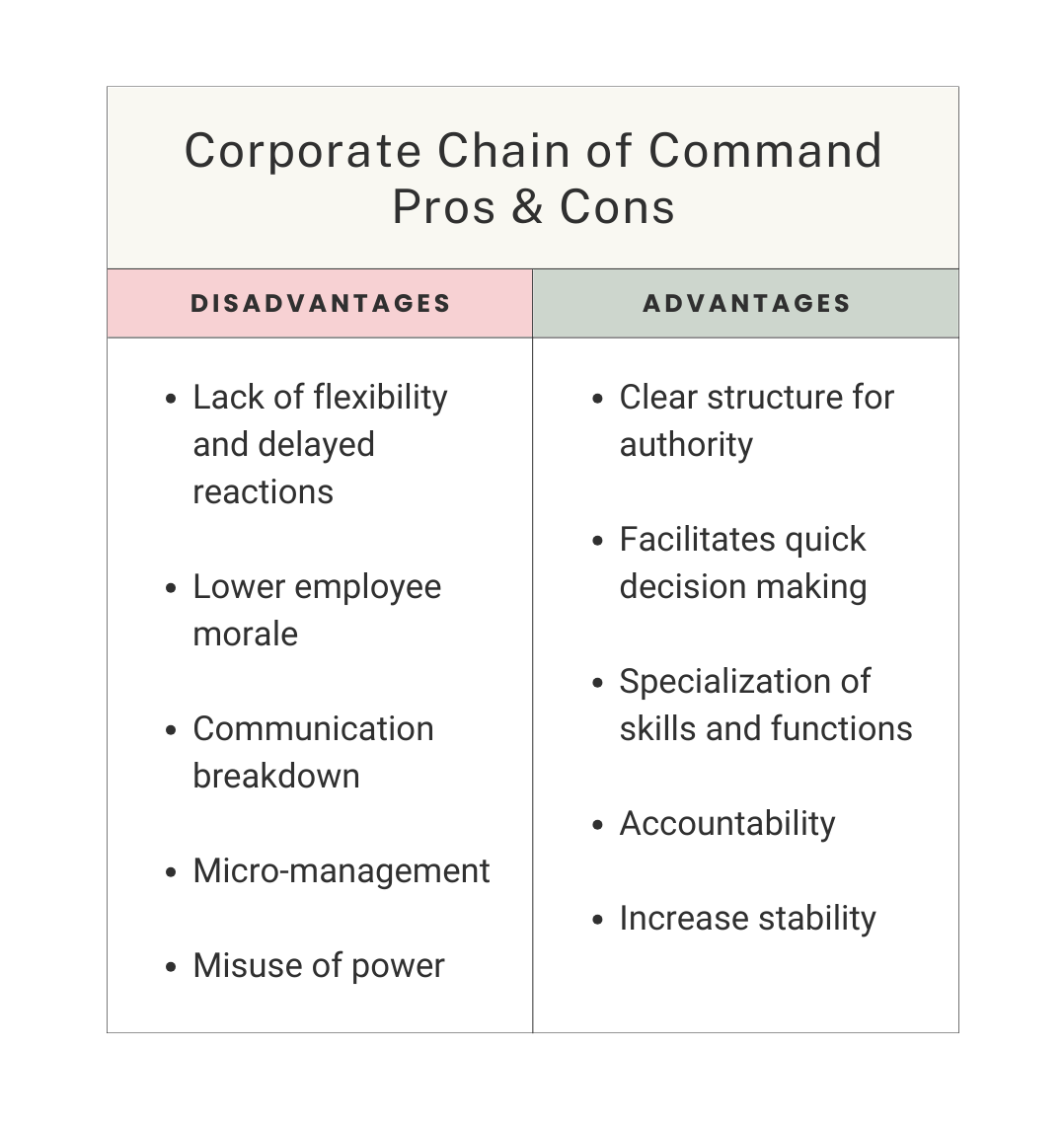Understanding the Chain of Command in Business
Let's take a look at the ins and outs of the chain of command in business and weigh up the pros and cons before implementing a rigid hierarchy.

You definitely are familiar with it if you have had experience working in a corporate environment; the chain of command is very important to know.
So what exactly is a chain of command?
It is a structured system that outlines how decisions are made, who has the authority, and what needs to done. This is critical for every sizable organization or company because it keeps everyone aware and organized.
A chain of commands prevents confusion when many people are making decisions simultaneously on the same issue.
Let's take a look at the ins-and-outs of the chain of command structure and why it matters.
Definition: What is Chain of Command in Business?
A chain of command in business is a hierarchy that helps employees to know who is under them and to whom they’re reporting and what their individual purpose is in the business.
Such hierarchy information comes in handy since it allows the personnel to know their exact duties and responsibilities and the appropriate contacts to raise concerns with.
Every large corporation has a strict chain of command from the most influential executives to the freshest hires. Between those two extremes are departments like advertising, sales, marketing, human resources, finance, and so on, and everything has its own designated duties.
Why Does Chain of Command in Business Matter?
1. Improves Communication Flow
By having a defined path of reporting, employees know exactly where to turn for approvals, guidance, and feedback. This reduces ambiguity and prevents mixed messages.
- Industry Insight: According to Harvard Business Review, the right organizational structure supports clear communication and decision-making, ensuring messages are consistent throughout the company.
2. Enhances Decision-Making Efficiency
When responsibilities and authority levels are transparent, decisions don’t get stuck waiting for multiple unnecessary sign-offs.
- Our Experience: For a healthcare services client, clarifying the chain of command at various clinics decreased the time to approve budget increases for new equipment. Decisions flowed more smoothly up a single line of authority.
- Supporting Research: McKinsey & Company’s research on agile organizations notes that establishing clear accountability and authority lines is key to efficient decision-making in modern, agile business environments.
3. Strengthens Accountability
A well-defined chain of command assigns ownership to specific roles, making it easier to identify where successes and failures originate. This clarity often leads to more proactive leadership and responsible decision-making.
- Authoritative Perspective: MIT Sloan Management Review’s study on organizational design for digital speed emphasizes that clear structures and accountabilities are essential for organizations to respond swiftly and effectively to changing market conditions.
Key Components of a Chain of Command in Business
- Hierarchical Levels:
Traditional structures often look like a pyramid, with C-level executives at the top followed by VPs, directors, managers, and employees. Each layer has defined responsibilities and reporting lines. - Span of Control:
This refers to how many employees report directly to a manager. Optimal spans vary by industry and role; too wide a span may dilute managerial effectiveness, while too narrow can create excessive bureaucracy. - Clear Job Titles & Responsibilities:
Consistency in titles and roles helps avoid confusion. Ensuring uniform understanding of what each title entails simplifies cross-functional collaboration and decision-making.
Practical Tip:
At OneDirectory, when we help clients set up organizational charts or employee directories, we advise standardizing titles and job descriptions. This ensures that employees interacting across departments share a common understanding of each other’s roles and where they fit in the hierarchy.

The Advantages of a Corporate Chain of Command
There are many reasons as to why it might be beneficial for a company to establish a short hierarchy or chain of command.
Eliminates Confusion: Having a command structure defining everyone’s role is one of the steps towards ensuring that people do not get confused about who their supervisor is and what they need to do in an organization. For any job to work smoothly it is imperative that people understand who they report to, what the expectations are and take ownership of their responsibilities so that they can perform their job effectively.
Increases Accountability: A command structure allows people to be answerable to someone for their role, work and associated obligations. In case things go amiss, people are bound to be answerable to higher authorities if such a structure is present.
Prevents Disputes: It is imperative that companies ensure there is a clear line of authority as this will reduce the chances of conflicts arising between the employees as well as other departments within the company. To avoid human bottlenecks, these individuals must be aware of their standing in the company and how copiously they contribute to the greater structure.
Helps in Making Decisions: It is very clear that decision making and conflict resolution is made easy when there is proper organization in place. The chances of confusion, in relation to who is addressing what area of their business, reduces when their roles are clear. Without a doubt, having an authority structure that allows your organization to work without overspending any time on a decision helps in solving potential issues.
For example, an entry-level employee wouldn’t decide on a new tech stack. That falls on the CTO. The front-line sales rep, however, can decide the right discount to offer a longtime client to close a deal.
The Disadvantages of a Corporate Chain of Command
Sadly, as good as there is, there is also bad and some of the downsides of having a systematic business structure are listed below.
Decision Bottlenecks: Command structures can get way too bogged down in detail creating a bottleneck for decision making. For example, if all decisions have to go through multiple hierarchy levels, that process would make getting things done take four times longer.
Ineffective Communication: More individuals involved in making a specific choice means more room for miscommunication. The ‘need to be in every single decision’ mentality ends up interfering with me deciphering messages and intentions which in turn irritates me. If communication is very important in your company, then tailor your command chain around those needed to make the decisions in that field.
Employee Discontent: Having a very rigid hierarchy would lead to discontent among workers and even managers.
In this case, if a larger number of people are participating in the decision-making, a sense of “power play” can be very apparent. The downside is that some people might think that their voice is not relevant or that their involvement is not appreciated enough.
To make sure no one’s voice is suppressed, no matter where you fall in your company’s hierarchy, try to dismantle useless walls between teams and departments in a corporate structure so that everyone feels equal and heard.
Levels of the Command Chain in Organizations
A business’s command structure is broken down into three main levels: upper management represented by CEOs and COOs, middle level management represented by directors, and lower management represented by workers who deal directly with the consumers and daily tasks.
The Top Level: Upper Management
The upper management would include everybody who is in complete control of the organization. This includes the CEO, the president, the managing director etc. These individuals have the most important role as everything in the organization falls under their domain. Everyone else in the organization is expected to report to these top level individuals.
The Middle Level: Middle Management
Below the top level individuals, there lies the middle management level. As the title suggests middle management members such as directors and managers operate in between the employees and upper management, and are responsible for ensuring the daily operations run smoothly by dividing tasks in the command chain to lower level employees.
A middle manager's job mainly revolves around tracking how well the company is doing and whether its targets are being reached. They regularly interact both with the upper management and lower management to ensure that every department is in the right direction to meet the organizations goals.
The Bottom Level: Frontline Employees
The bottom level in a typical chain of command structure consists primarily of frontline employees. These workers are being instructed by their managers on what is the best way to carry out their operations. They may also be assigned the task of reporting how well they carried out their supervisors or the manager.
There ought to be clear roles and expectations at different levels of the command hierarchy so that every person knows what they are supposed to be doing at any point in time.
Using Org Chart Software to Visualize Your Chain of Command
Whether you’re a small business owner or a manager in a large organization, it’s important to have an accurate, up-to-date view of your chain of command.
The best tool with which to do this is an organizational chart diagram.
Org chart diagrams are a perfect way to help you visualize your organization's chain of command since they typically display your organizational structure in a top-down reporting hierarchy, like this:

Org chart diagrams themselves are typically created using organizational chart software, also referred to as org chart software. By using a software-based org chart to visualize your chain of command, as opposed to an org chart diagram built manually in a spreadsheet or printed on paper, you are able to do certain things that you otherwise couldn't with a static org chart.
For example, modern org chart tools like OneDirectory allow you to highlight "paths" within your organization's pecking order. This makes it easier to visualize the command structure in more complex organizations where there may be many layers of management.
How to View Your Chain of Command in OneDirectory
Looking for an easy way to visualize and navigate your chain of command? Well, here's how you can do it using OneDirectory.
Quickly see your command line and where you stand in the organization by heading over to your profile (or anyone else's). On the right, you'll see this neat little mini-org chart. It's like a snapshot of your place in the company's pecking order, showing who you report to and who reports to you.

But if you're looking for the full picture, the interactive org chart in OneDirectory is the way to go. You can quickly trace your chain of command by clicking the ellipsis on your org chart card and selecting 'highlight path'. It's like lighting up a path through a forest – it'll show you your command structure to the top of the organization tree.

Frequently Asked Questions
What does a chain of command mean?
A chain of command is a system used in an organization to uphold clear reporting and authority relationships, ensuring that decisions and orders flow from higher management down to the lower ranks in a smooth manner.
What are the different types of chains of command?
There are only two main types which include the following;
- Vertical Chain of Command: A style of management that has multiple levels where every lower level answers to an upper one.
- Horizontal (Flat) Chain of Command: A method that has less hierarchical levels, allowing a better and more supportive working environment.
How can a business implement an effective chain of command?
To implement an effective chain of command:
- Clearly define roles and responsibilities.
- Establish open communication channels.
- Provide training and development for leadership.
- Ensure flexibility to adapt to organizational changes.
How does chain of command impact company culture?
A well-structured chain of command improves trust, reduces workplace politics, and fosters accountability. Employees who understand the hierarchy and their place within it are more likely to feel secure, act confidently, and collaborate effectively.
About the Author
Greg Bennett is the COO at OneDirectory and a seasoned expert in organizational leadership, employee engagement, and enterprise collaboration. With over 10 years of experience, Greg specializes in helping businesses streamline communication and boost operational efficiency.
As a thought leader in employee directories and organizational structure, Greg has authored more than 100 articles on topics such as org charts, Microsoft 365, and employee data management. His strategic insights empower companies to foster team alignment and engagement while enhancing productivity.
If you’d like to learn more about establishing an effective chain of command or need assistance in visualizing your organizational structure, contact OneDirectory. Our team specializes in solutions that help businesses create, maintain, and leverage clear hierarchies for long-term success.


